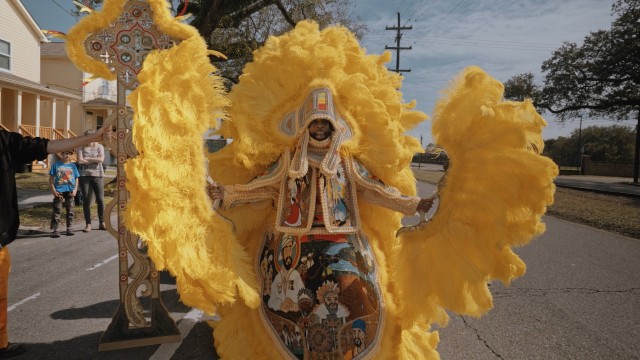A week ago to the day, Fat Tuesday saw an end to this year’s Mardi Gras season in New Orleans and here at Short of the Week we wanted to celebrate, too. You’re probably most familiar with Mardi Gras as a string of ceaseless parades, drunken antics, glittery shoes, and plastic beads that smack you in the face if you’re not careful. However, speaking as a native New Orleanian, there is much more to this fanfare than meets the eye. In Mardi Gras we also find incredible nuance, hallowed traditions, and above all, community. Living at this nexus is Michal Pietrzyk’s portrait of Mardi Gras Indian or Black Masker, Big Chief Demond Malancon, in his documentary All on a Mardi Gras Day.
Demond is hard at work when we meet him, crouched studiously over his work desk like a scholar deciphering ancient texts. What books are to an academic, beads are to this Big Chief. All year, Demond has been meticulously sewing them into the suit he will don on Mardi Gras day. Small beads, big beads, feathers. Though it is not yet complete, we are already awed by Demond’s discipline, skill, and craftsmanship. In a city where 1 in 14 young black men will be victims of homicide, Demond preaches a certain kind of peace as he chants, “you’re not going to fight ‘em, you’re not going to shoot ‘em, you not going to stab ‘em, you’re going to kill ‘em with that needle and thread.”

“When he allowed us into his sewing room, we knew we had been given access to something incredibly special” – director Michal Pietrzyk on the inspiration behind All On A Mardi Gras Day
This proverbial needle and thread is in many ways the very thing holding Demond’s community together. The soaring cost of rent due to rapid gentrification has pushed him from his childhood home and the city he so loves. It is not just Demond who is displaced, but fellow Mardi Gras Indians and entire neighborhoods. With the fracture of these families also comes the fracture of their shared histories and traditions. Though his suit is as costly as it is time-consuming, Demond won’t quit. He keeps his culture alive, not only for himself but for the future. For those fatherless boys who need a Big Chief.
New Orleanians are famously skeptical of outsiders and admittedly, I was a bit wary going into Pietrzyk’s film. Bead by bead, feather by feather, night after night ‘till Mardi Gras, I was won over. Pietrzyk’s camera is discreet and intentional. His visual language subtle yet pointed. Instead of co-opting the microphone he hands it wholly to Demond, allowing him to sew his own story the same way he sews his suit: rigorously, realistically, and passionately. In what could have easily been an exploitative, cursory look into his culture, Pietrzyk renders it with the nuance it deserves.
With great hardship comes great resilience, and Demond’s is undeniable. When you’re poor in New Orleans you have to fight to survive. Some fight with their fists. Some fight with weapons. Demond fights with art. He rebels against the prison industrial complex, the alarming erosion of primarily black-owned homes, the parts of Mardi Gras entrenched in white supremacy, and all those other systems that would try to eradicate him, his history, and his community. Thankfully, Demond is not alone. He is surrounded by Mardi Gras Indians.

 Lorraine Caffery
Lorraine Caffery